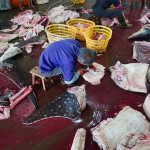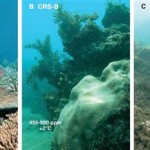…because it has already happened. During a conference this summer, I heard Jeremy Jackson give talk. He highlighted the severely degraded state, as measured by just about any metric, of Caribbean reefs. Observe one of his talks or take a quick read of his papers and you will find yourself in the fetal position crying. Choice quotes from his papers
- Comparison of Pleistocene and modern community structure shows that Recent human impacts have changed coral community structure in ways not observed in the preceding 220 000 years
- The overall historical trajectory of reef degradation across all cultural periods is strikingly linear, despite the wide range of values within any one cultural period. Most importantly from the perspective of reef conservation and management, most of the reef ecosystems were substantially degraded before 1900.
- Populations of endangered Caribbean sea turtles are far more depleted than realized because current conservation assessments do not reflect historic nesting data…Our results indicate that 20% of historic nesting sites have been lost entirely and 50% of the remaining nesting sites have been reduced to dangerously low populations.
- The productivity and biomass of pristine coral reef ecosystems is poorly understood, particularly in the Caribbean where communities have been impacted by overfishing and multiple other stressors over centuries. Using historical data on the spatial distribution and abundance of the extinct Caribbean monk
seal (Monachus tropicalis), this study reconstructs the population size, structure and ecological role of this once common predator within coral reef communities, and provides evidence that historical reefs supported biomasses of fishes and invertebrates up to six times greater than those found on typical modern Caribbean reefs. An estimated 233 000–338 000 monk seals were distributed among 13 colonies across the Caribbean. The biomass of reef fishes and invertebrates required to support historical seal populations was 732–1018 g mK2 of reefs, which exceeds that found on any Caribbean reef today and is comparable with those measured in remote Pacific reefs. Quantitative estimates of historically dense monk seal colonies and their consumption rates on pristine reefs provide concrete data on the magnitude of decline in animal biomass on Caribbean coral reefs. Realistic reconstruction of these past ecosystems is critical to understanding the profound and long-lasting effect of human hunting on the functioning of coral reef ecosystems. - Ecological extinction caused by overfishing precedes all other pervasive human disturbance to coastal ecosystems, including pollution, degradation
of water quality, and anthropogenic climate change. Historical abundances of large consumer species were fantastically large in comparison
with recent observations. Paleoecological, archaeological, and historical data show that time lags of decades to centuries occurred between the
onset of overfishing and consequent changes in ecological communities, because unfished species of similar trophic level assumed the ecological
roles of overfished species until they too were overfished or died of epidemic diseases related to overcrowding.
Corals…gone, turtles…gone, fish…gone, seals…gone, and all the other species yet to be quantified…gone.
So that was to be the post. Everyone feels nauseous or a least ‘environmental degradation’ induced vertigo. But then I get this email from Jives
This weekend I opened my inbox to find some powerful words from Les Kaufman about coral reef ecology. He’s writing reports from the Enderbury Island dive site in the Phoenix Islands Expedition. On Sunday he wrote: “This is the first time I’ve felt, with full conviction, that the reduction
of human coastal impacts could significantly help the ocean to heal itself.”This morning I put up a post that explained why: “The moment we dropped into the sea just off NAI’A’s bow in the lee of Enderbury, our mouths fell agape and stayed that way for the entire dive and a good while afterwards. A fully regenerated reef! Over 90% coral cover, sharks, dogtooth tuna and the joy of having a good reason to be careful about neutral bouyancy. The transect methodology was the same tired old routine, but we felt like whistling the entire time.”
The 2005 expedition found these reefs severely damaged by a coral bleaching incident. The research team has been cautiously optimistic until now… But this seems to border on full-on optimism. Reading the posts as they go up, I get a pretty good idea of what’s going on with the expedition, but the power of that statement kind of overwhelmed me, especially coming from Dr. Kaufman.
What? There is hope? This email combined with the OCEAN initiative by David “WhySharksMatter” Shiffman are actually make me a bit warm an fuzzy. In case you haven’t heard…
I am announcing the formation of a new volunteer-based conservation group : the Online Community Environmental Action Network (OCEAN). The purpose of this group is to use online resources to spread conservation related information. Members of OCEAN will help spread the word about certain blog posts, petitions, multimedia resources, and conservation websites. They will do this via the following online resources [Facebook, Digg, Neatorama, Twitter]
Take some time and head over to the Southern Fried Scientist to learn more about this important effort and how you can join. Do it because I am tired of losing sleepless nights, curled in the fetal position, weeping






Hi there. We believe tomorrow can be better than today, much as we are standing on an ever-steeper slippery slope. Thank you kindly for your excellent post, which I will share with Shark Rescue’s supporters. Victor Hugo wrote that nothing is stronger than an idea whose time has come. Shark Rescue is asserting that the time has come for action around marine conservation. Again, thank you for your post.
Super post, Need to mark it on Digg
SonyaSunny